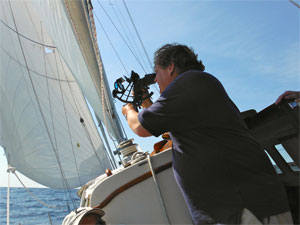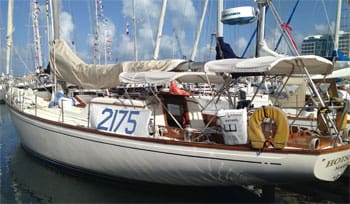It was 0430 and the question was: Do you know where your boat is? That was the issue Tuesday morning, June 18, our last daybreak (presumably!) as we sailed in the celestial class in the 2013 Marion Bermuda Race. Up to that point we had experienced four days of fantastic reaching at, or above, hull speed.
But all things come to an end. We were south of the Gulf Stream where many a strong showing has come to grief in the Bermuda High. Light, variable winds from the south were pushing us to the east, and when you are dead reckoning, this is more than an annoyance. It’s a real problem. A few meager knots of boat speed chasing happy tell-tails all over the compass makes course and speed more of a mystery than Heisenberg’s uncertainty principle. You start making position assumptions based on probabilities, not facts.
To be sure, careful recording keeping is key. The celestial navigator can only get a fix a few times a day. Once at noon, the beloved noon-shot, favored by more casual navigators and requiring no reduction tables; running fixes which combine dead reckoning with lines of position, usually of the sun, and, of course, the gold standard of celestial navigation: the three-star fix, once at dusk and once at dawn. Without reliable course and speed information, a running fix becomes pretty useless. The radius of your probable position becomes pretty big.
 |
|
Kenneth van Colen |
|
Wisner getting a sun line during the race. |
Bermuda is surrounded on the northwest by coral reefs, which extend far out to sea. At 0841 GMT (0430 local) I had one chance to get a latitude as we approached Bermuda that last day. There was some haze, a little cloud cover, but I saw one fairly bright star in the south in the quickly lightening sky and I knew that that star was the priority, hang the other two of my morning triad. That star would give me a line of position perpendicular to its azimuth (the compass bearing to its position over the sea) and that line would be essentially equivalent to my latitude. I could get our longitude later when the sun came up.
When I was learning how to do all this, the stars in particular seemed very daunting. Tim Queeney, my celestial navigation instructor (and the editor of this magazine) assured me that despite my trepidations, the HO 249 Volume 1, Selected Stars, really would work as advertised. Get the local hour angle of Aries, and find your latitude in the volume. Pick up the azimuth and altitude of the star then pre-set your sextant to that altitude of the star, aim the sextant at the horizon using a hand-bearing or the ship’s compass, and voilà, the star appears in your scope. It will not appear precisely on the horizon, that’s your job, to make the fine adjustment and take the exact time when you have done so. My star turned out to be Fomalhaut.
When Queeney teaches celestial navigation, as he has done for decades, it is a condensed course of two days of pencil and paper work. It’s the only way. It seems impossibly arcane at first, but the repetition pays off. Doing it by hand makes you internalize the steps so it becomes second nature. My first reductions took more than half an hour. Now I do them in five minutes. No computer, no calculator. Just my pencil and a big pink eraser. And having the arsenal of different celestial bodies, from stars to the sun to the planets at your disposal means that you will be ready, as I was, to make that quick decision under changing conditions, and find your boat’s position in a big ocean, no matter what happens to your electronics, or your batteries. It’s a skill that I think everyone who calls themselves a sailor should have, because as many a wise bluewater sailor has said, if it can break, it will.
————
Ronald Wisner is the owner and skipper of Hotspur II, a Columbia 50 that finished second in class and won the celestial navigator’s trophy in the 2013 Marion Bermuda Race.

